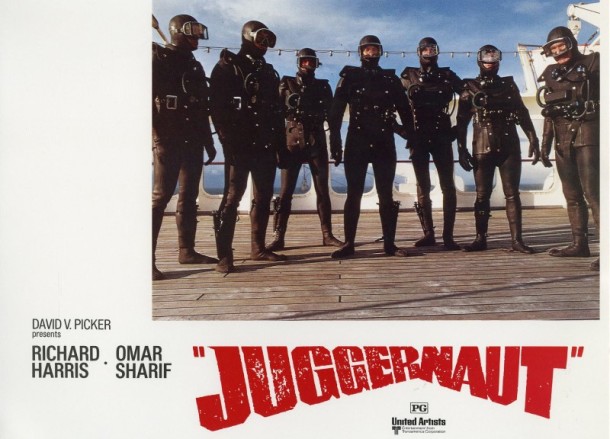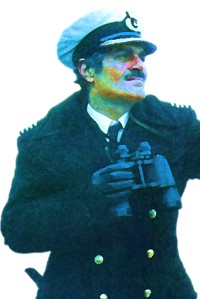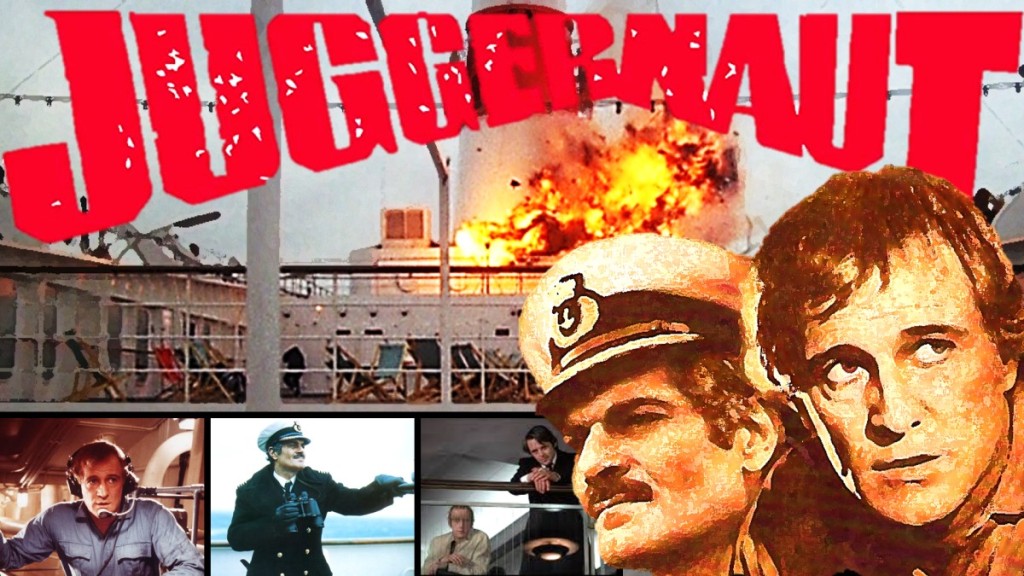SIMON MATTHEWS watches Richard Lester’s 1974 film Juggernaut.
London, March 1974. Having just defused a terrorist bomb in the National Gallery, two bomb disposal officers emerge and survey the afternoon crowds in Trafalgar Square. One of them remarks sarcastically: ‘Doesn’t anyone in this country work anymore?’ It was a topical allusion. Edward Heath had just been ousted as prime minister by Harold Wilson and the three-day week had given way to normal working arrangements, though some restrictions on the use of electricity remained in force.
The scene occurs early on in Richard Lester’s Juggernaut, not long after the basics of the plot have been set out. These concern the SS Britannic, a large cruise ship embarking passengers for its latest trip across the Atlantic. A day or so out to sea it turns out the ship is poorly maintained. There’s trouble in the engine room. A refit has been botched. The captain is disillusioned. There are now immigrants amongst the crew: cue an interesting turn from a young Roshan Seth as a dining room waiter explaining his puzzlement at how, having been the wrong colour in East Africa, he now finds himself the wrong colour in the UK too.
Even worse, the owners then get a call from that dreaded 1970s trope, the ‘man with an Irish accent’, advising that seven thousand-pound bombs are on board and demanding a hefty ransom. Cut to the bomb disposal men being told what their next job is.
Juggernaut originally started out as a dramatization of the May 1972 QE2 bomb alert. Despite turning out to be a hoax, the heroics of the SAS, who flew out to the mid-Atlantic and parachuted into the sea to rendezvous with the ship, had clear cinematic/morale-boosting potential. Pitched as something like an early version of Who Dares Wins crossed with The Poseidon Adventure (a massive success which took in box-office receipts 25 times what it cost to make), the idea was to celebrate British expertise and show a country that could still deal with whatever was thrown at it.
Announced in 1973 as a Bryan Forbes film – Forbes having just left EMI Films and in need of a hit – Richard Harris and Omar Shariff were quickly signed up for the leading roles. Which was perfectly logical: if you were making an action film in 1973, then Harris and Shariff were just what you wanted. Somewhere along the way, though, Forbes felt uneasy and quit to make The Stepford Wives. After floundering around for a while, and with the clock ticking down, the producers finally lined up Richard Lester.
He immediately re-wrote the script with TV dramatist Alan Plater. Plater had worked on the UK’s police procedurals Z-Cars and Softly, Softly and what emerged was much less of an action/disaster movie and much more like a political thriller. Significant supporting actors were cast (among them Ian Holm and Anthony Hopkins) and the cameras began to roll. There were still incongruities – an Egyptian captain? An Irish hero in a terrorist drama? – including, most notably, the ship itself.
With the QE2 not being available the producers reached an agreement to use the German Hanseatic… which by the time they started filming had been sold, due to rising costs caused by the 1973 oil price hike, to the Soviet Union. Renamed the Maksim Gorky and freshly repainted in the colours of the Black Sea Shipping Company, including a red band with hammer and sickle on the funnel (kept out of focus by adroit camera work) she plays the part of the Britannic.
Initially, the plot follows the 1972 events. The ransom demand is made. The bomb disposal people fly out and parachute down to her. Then it diverges, and cuts between the action on board and a desperate chase back in the UK to find the perpetrator. Things go badly on the Britannic. One of the bombs detonates prematurely, killing one of Harris’s assistants. Somehow the ship struggles on, partially blacked out and wallowing in poor weather, the passengers gathered in evening dress in the ballroom for a last dance. The engines are shut down and they prepare to abandon ship.
And then… it isn’t ‘Goodbye UK, it’s been nice knowing you’ after all. The police track down the perpetrator, who turns out not to be Irish. It’s a disgruntled, retired military man. A fanatic, an ‘enemy within’. Harris, doing a fine turn as an anti-authority, anti-hero cuts the right wire, just in time. The Britannic is saved, and in a typically downbeat ’70s ending sails slowly away, its people having come through a great ordeal.
Juggernaut was released in September 1974 to average reviews and modest takings. There was something deeply ironic about Richard Lester – one of the key ringmasters of Swinging London – portraying the state of the nation in the 1970s. Doubly so, given the cast includes David Hemmings, he of Blow-Up and much else, expended here halfway through the film. How times change.
Most commentators referred to it (and still do) as a disaster movie, which it clearly isn’t. Perhaps allegories, set on a boat, are a bit tricky for British audiences to ‘get’. After all, Federico Fellini’s wonderful And the Ship Sails On (1983) didn’t do well in the UK, and Alan Ayckbourn’s play Way Upstream (1981) isn’t reckoned one of his major successes. In recent years neither Francis Beckett nor Dominic Sandbrook have mentioned Lester’s film in their compendium histories. It looks today like an early outlier for some of the allegorical stuff that came later. Perhaps it’s time to reclaim Juggernaut for what it is, and enjoy the political points its makes amidst the drama and chaos.
from the maker of:
see also:






